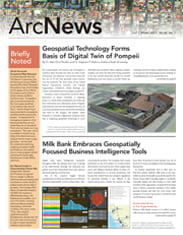Organizations, government agencies, and communities around the world are urgently trying to foster equity in their institutions. To generate equity, these groups need to implement solutions that meet the needs of the underserved and unserved, whether those conditions stem from racism, variations in physical or mental health, lack of access to services, the effects of climate change, or other circumstances.
We all want to live in a more equitable world. But what does that mean in practice? With budgets to abide by, constituents to listen to, and limited time and resources, how do our leaders aim to make a more equitable world despite real-world constraints?
While governments, nongovernmental organizations (NGOs), and community groups seek ways to incorporate equity into their existing workflows, many GIS users have discovered that they already do this through geospatial technology. For state and local governments that employ the geographic approach, for instance, equitable thinking is already ingrained in their daily work. Public works professionals who maintain streetlights, sidewalks, park benches, drinking fountains, and public restrooms are pushing toward equity of open and green spaces. Social services and public health staff who collaborate with community-based organizations to improve access to medical facilities, prescription services, and preventative health care are striving to achieve health equity. Transit planners who expand bus, train, trolley, and ferry service and improve mobility for people of all abilities are making progress toward equity of movement.
GIS provides the data, tools, and geographic lens through which to approach, discuss, and address equity issues. Using ArcGIS technology, governments, NGOs, and community groups can identify the needs of their clients and constituents and prioritize areas for intervention and long-term investment.
But many organizations—even the ones already using GIS—lack an enterprise-wide strategic plan for achieving equity. A plan like this outlines the organization’s overarching equity goals and details how GIS can be leveraged to support these objectives, empower staff to take action, track program effectiveness, and communicate results.
A strategic equity plan helps organizations establish an organizational strategy for achieving equity rather than relying on ad hoc, project-by-project or department-by-department results. With a strategic equity plan in place, organizations can better understand their community’s needs, identify opportunities to intervene, and develop solutions that enact real change. They can also use the plan to introduce tools to foster involvement from community leaders, residents, and other stakeholders.
So how can an organization build a strategic equity plan and put it into practice? By following four simple steps.
-
1. Understand Your Community
To build a strategic equity plan, organizations first need to add an equity lens to how they approach their work. This involves gaining a better understanding of the communities they serve and their needs, which requires taking a spatial approach.
To start heading in the right direction, decision-makers should ask themselves the following questions:
- How well do we know the communities we serve, both in general and geospatially?
- Where are those without access to our key services (like broadband or transit) located? What age groups, races, or ethnicities do they belong to?
- Who are the local community leaders in the area?
GIS can be used to answer questions like these to provide decision-makers with more insight into where there’s a lack of service and who is affected by it. When organizations understand their communities geospatially—by visualizing demographics, patterns, and trends in maps—they can make more informed decisions and discover opportunities to engage with their clients and constituents. Once organizations better understand their communities, they can prioritize where to put their resources and investments.
-
2. Build a Location Strategy
A location strategy is a high-level vision for using geospatial technology as a key method to finding answers to problems. For decades, geospatial technologies such as GIS have helped organizations of all sizes unlock the full potential of data to remain agile, improve services, and meet new challenges.
Governments, NGOs, and community organizations can achieve equity when they apply a location strategy to all their work and employ GIS to help achieve it. During the COVID-19 pandemic, for example, libraries across the United States experienced upticks in Wi-Fi usage when schools and workplaces closed. Overlaying the locations of these libraries with data on broadband coverage showed where critical gaps existed. Local governments were able to take these location-based findings to inform where broadband build-outs needed to take place to foster equity in access to information.
A location strategy can be used to take on issues department by department or tackle a cross-cutting challenge, such as homelessness or the local impacts of climate change. These efforts, in turn, aim to meet more substantial goals, like increasing economic opportunity, improving mobility, or achieving healthier and safer communities.
-
3. Deliver Real Solutions that Address Your Priorities
Once organizations have embraced a location-centric approach, they need to deliver data, tools, apps, and solutions to employees and decision-makers that will allow them to consider equity and incorporate equity-based approaches in their work.
Returning to the broadband example, an ArcGIS Survey123 form can be used to gather data from residents and business owners on broadband access to further inform who lacks it and where broadband service needs to be expanded. In another example, real-time dashboards, built with ArcGIS Dashboards, can be used to monitor air quality, and air quality maps can be overlaid with demographic data to pinpoint which populations are adversely affected by pollution. Esri also has ArcGIS Solutions configurations—such as the Social Equity Analysis and Police Transparency solutions—that provide focused maps and apps to help organizations perform targeted analysis and increase community engagement.
By employing performance monitoring dashboards, public information hubs, and feedback tools, organizations can gain valuable insight into where their efforts would be most effective and how to equitably allocate resources so that underserved and unserved populations have better opportunities for success.
-
4. Measure Your Impact
Putting a strategic equity plan into operation allows organizations to turn abstract ideas and observations into measurable results. When staff members have the tools and solutions they need to incorporate an equity lens into their work, entire organizations can begin to see and measure the impact of their initiatives.
Use GIS-based hubs and dashboards to develop indexes and models that can be used to set benchmarks and establish milestones. Tools like these allow organizations to model alternative approaches to attaining their goals and see where adjustments need to be made along the way. And throughout the process, leverage apps like ArcGIS Survey123 to do quantitative and qualitative data collection, ArcGIS Business Analyst to analyze the data, and ArcGIS Hub and ArcGIS StoryMaps to communicate progress with community members.
Now, it’s time to get started. Follow these four steps to develop a strategic equity plan, and begin investing your organization’s time and resources where they are needed most.


